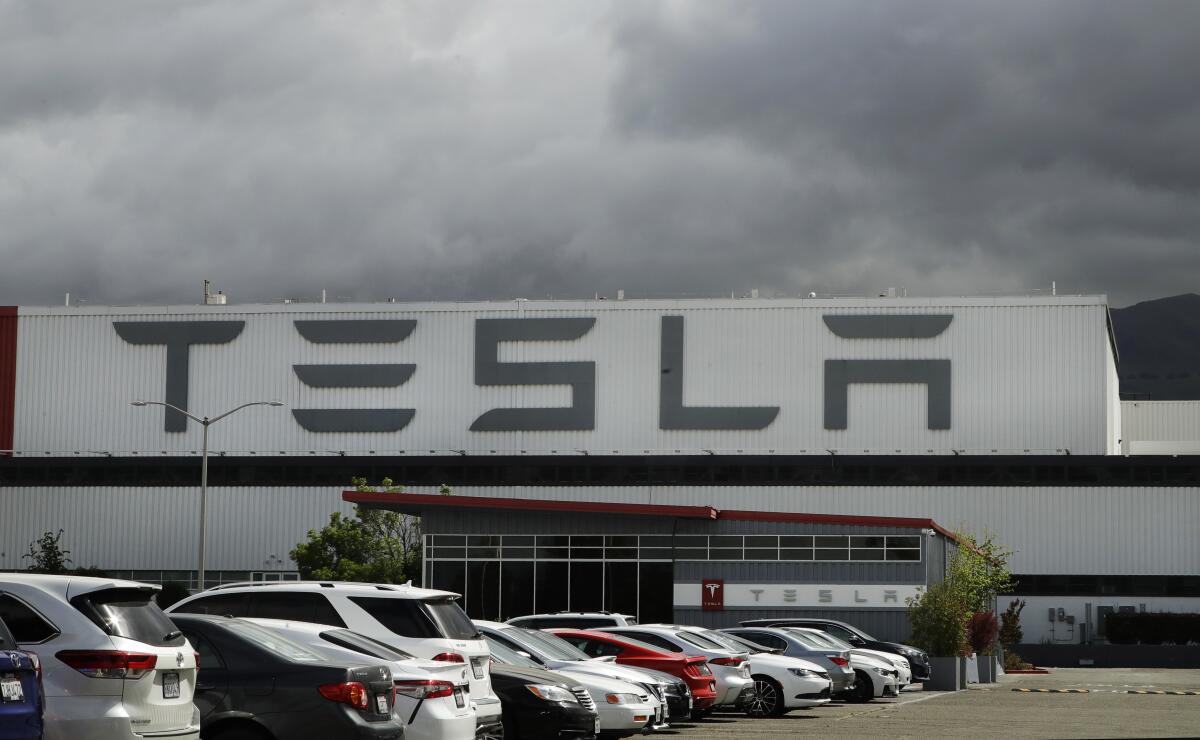Tesla shares slide after disappointing Wall Street on profit, margin

- Share via
Tesla Inc. reported a lower-than-expected fourth-quarter profit and lower margins, a result that sent its shares sliding in post-market trading.
The automaker blamed aggressive price cutting in China, supply chain costs and a big pay package for Chief Executive Elon Musk and other executives for operating margins that shrank to 5.4% in the latest quarter, down from 9.2% in the previous three months.
The Palo Alto company reported a fourth-quarter profit of 80 cents a share Wednesday on an adjusted basis, falling short of analysts’ consensus estimate for $1.03 and well below the blowout $2.14 of a year earlier. It marked the company’s sixth consecutive quarter of profit.
Tesla shares dropped as much as 7.6% in after-hours trading but pared the loss to 4.3% as of 4:51 p.m. in New York. They fell $18.93, or 2.1%, to $864.16 in regular trading.
Tesla did not give a specific number for how many cars it expects to deliver in 2021 but said that it anticipates beating last year’s 50% growth rate, which would mean more than 750,000 units. It delivered almost 500,000 vehicles globally in 2020.
Despite missing analyst estimates for profit, the results cap a remarkable year for Tesla. The company has defied skeptics by achieving sustained income growth and been rewarded with a record stock price and placement on the Standard & Poor’s 500 index. Its success has helped spur a rally in shares of other companies with electric-vehicle strategies, both old and new.
Tesla’s revenue hit $10.74 billion in the October-to-December period, surpassing analysts’ estimate for $10.38 billion and exceeding the $7.38 billion in the last quarter of 2019.
The company earns money by selling regulatory credits to automakers that need them to comply with carbon-emissions standards in California, Europe and elsewhere. Investors view this revenue as a double-edged sword because they want to know Tesla can be profitable from its core business: making and selling cars. Sales of regulatory credits were $401 million, up from $397 million in the third quarter.
Tesla said that it has been upgrading its factory in Fremont, Calif., to launch refreshed versions of its S and X models with new powertrains and entirely new interiors. A photo in the shareholder letter shows a small screen for passengers in the back seat. The first deliveries of the Model S began in 2012, and speculation about an overdue refresh has circulated for months.
Musk addressed the company’s stratospheric stock market valuation in a conference call with analysts after the earnings announcement Wednesday. Last year, he promised 1 million self-driving Tesla robotaxis would be on the road by the end of 2020. He turned to that theme again Wednesday to explain Tesla’s stock price. Once Tesla’s so-called Full Self-Driving technology emerges from its initial “beta” stage and offers truly driverless capability by the end of 2021, he said, revenue from robotaxis could justify the company’s current stock market value of nearly $900 billion.
Musk has been promising since 2016 that full self-driving Tesla cars are right around the corner. Despite his pledge, Tesla delivered no robotaxis in 2020. Tesla’s Full Self-Driving system, which costs $10,000, is not an autonomous system yet but incorporates a so-called Level 2 driver assist technology that requires constant human attention.
Asked during the conference call why he’s confident Tesla can reach fully autonomous Level 5 by year’s end, Musk said: “It’s based on progress we’re making in each beta iteration.”
Times staff writer Russ Mitchell contributed to this report.
More to Read
Inside the business of entertainment
The Wide Shot brings you news, analysis and insights on everything from streaming wars to production — and what it all means for the future.
You may occasionally receive promotional content from the Los Angeles Times.










